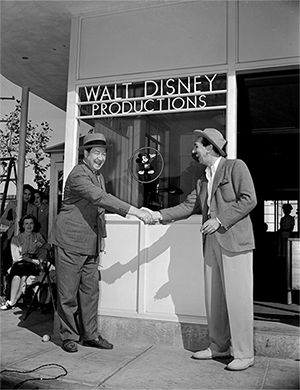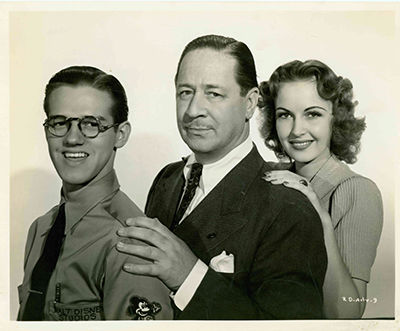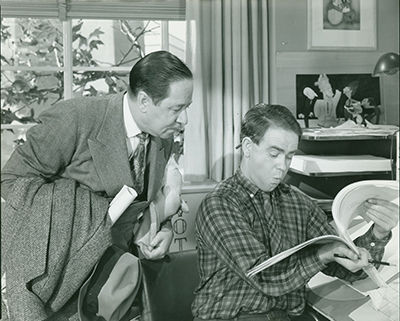
For many of us who never met the man, the image of Walt Disney etched in our heads is often that from the Disneyland television program of the 1950s and 60s—an older Walt, clothed in a blue suit with charcoal-grey hair and a grandfatherly way of speaking. It is this image, broadcast every week on television screens, which became the stuff of legend, a mythical icon for generations to follow. But it is in The Reluctant Dragon (1941) that we are gifted a rarer glimpse of Walt at an earlier stage in his life, a time when he had already reached great heights of success, but still had many more challenges and triumphs yet to endure.
Walt Disney’s fourth feature film, and perhaps one of his least known, The Reluctant Dragon was released in June of 1941, now 75 years ago. The film itself is a delightful gem of live-action and animation, and is now as much a piece of history as it is entertainment. The film follows famed writer and humorist Robert Benchley (playing himself) as he ventures throughout the then brand-new Walt Disney Studios in Burbank, anxious to share a story with Walt that he thinks might make a good cartoon picture. Along the way he has many silly encounters with artists, animators, voice talents, and other employees, experiencing little stories at each new meeting.
At the time of Dragon’s filming, a pedestrian walking along Mickey Avenue on the Burbank lot could look out beyond the confines of the studio across an extended horizon of the flat San Fernando Valley capped with towering mountain peaks in the distance. The campus, freshly constructed with the profits from Snow White and the Seven Dwarfs (1937), featured the latest and greatest in architectural design and amenities, courtesy of famed architect Kem Weber. Dragon was filmed right on the lot itself, giving us a rare glimpse of the new facility. Interiors were filmed on sets constructed inside the Studios’ soundstage to replicate the actual artists’ rooms and working facilities.

By 1941, Robert Benchley was a national treasure. One of America’s great humorists, he had been a member of the “Algonquin Roundtable,” a legendary group of New York writers who’d regularly gather at the Algonquin Hotel in Manhattan. As he himself would famously write, “I have tried to know absolutely nothing about a great many things, and I have succeeded fairly well.” Benchley’s dry wit and unbreakable curiosity made him an apt character to explore the halls of Walt’s studio, learning more about the mysterious animation process at each stop in his journey.
As a piece of entertainment, the film showcases some wonderful scenes of humor accompanied by a delightfully playful musical score developed by Disney veterans Frank Churchill and Larry Morey. Ever trying to flee from the company of Humphrey, a hard-nosed studio guide played by Buddy Pepper, Benchley engages in fun-filled antics with voice artists Clarence Nash and Florence Gill. Hollywood starlet Frances Gifford, in her role as Doris, a studio artist, shows him the many technological wonders of the production facilities, including the multiplane camera. Another group of artists, one of whom is played by actor Alan Ladd, pitches the storyboards of a new short film entitled Baby Weems. Perhaps the emotional center of the film, Weems features highly effective minimalist animation and remains a relatively uncelebrated gem of Disney storytelling.

Benchley also finds himself wandering into one of the animators’ rooms, where this time the artists are played by the men themselves. “Say, what goes on, pal?” the now legendary Ward Kimball proclaims to Benchley as he stumbles upon their room. Kimball, Fred Moore, and Norm Ferguson take center stage to demonstrate their abilities of bringing drawings to life. Kimball, with his ever-original sense of humor, animates Goofy as Benchley looks over his shoulder. And later, Ferguson catches Benchley’s attention as he sits at his desk, panting like a dog as he takes a “method” approach to animating Pluto.
After his encounter with the animators, Benchley finally arrives at a screening room packed with Studios’ talent including Frank Churchill, Hamilton Luske, Ted Sears, and T. Hee among many others. Escorted by Humphrey, Benchley is finally introduced to Walt himself. Relaxed and casual, Walt has his legs tucked up in his chair. He wears a green shirt and trousers, far from his business suit of later decades. “Oh hello, Bob. How are ya?” he says to Benchley. Humphrey quickly demands Walt sign a “proof of delivery,” and as he does so Walt almost off-handedly says to the group, “Boys, this is Bob Benchley.” The group mutters a “hello” in response. Having finally arrived, Benchley becomes overwhelmed with the many souvenirs he’s acquired and anxiously attempts to find the copy of “The Reluctant Dragon” storybook that he had hoped to show Walt. Just as he manages to pull it out, the screening room goes dark and the projector begins rolling. We soon discover that the new film the group is reviewing is in fact an adaptation of the very book that Benchley had hoped to pitch!
In this all-too-small collection of shots, we are given a view of Walt Disney at forty, still very much the boy at heart. We see the man at the cusp of massive shifts and changes soon to come in his life. Mere months later, the Studios’ labor strike would begin, and within the year the attack on Pearl Harbor would bring America into the Second World War. The Walt we see in The Reluctant Dragon is the man who made Snow White and the Seven Dwarfs, who dreamed of Pinocchio (1940) and dared to make Fantasia (1940). We see the Walt who was then in the midst of finishing Dumbo (1941) and pushing the production of Bambi (1942) to new heights. We also see the Walt who was a loving father to Diane (aged seven) and Sharon (aged four). For a few brief moments we can see and imagine just what it was like to sit next to Walt in a studio screening room, twisted like a pretzel in his chair.
“We’re just going to run a new picture. You want to sit through it?” he asks Benchley. “You can roll whenever it’s ready.” With The Reluctant Dragon we not only have an opportunity to explore The Walt Disney Studios of 75 years ago, but we also have the chance to sit back in our chairs, fold up our legs, and watch a film at Walt’s side.

Lucas O. Seastrom is a writer, filmmaker, and contracting historian for the Walt Disney Family Museum.
Sources
Canemaker, John, and Herman Schultheis. The Lost Notebook: Herman Schultheis and the Secrets of Walt Disney's Movie Magic. San Francisco: Walt Disney Family Foundation, 2014. Print.
Benchley, Robert. Chips Off The Old Benchley. New York: Harper, 1949. Print.
Maltin, Leonard. The Disney Films. New York: Crown, 1973. Print.
The Reluctant Dragon. Dir. Alfred L. Werker. Perf. Robert Benchley. Walt Disney Studios, 1941. DVD.
